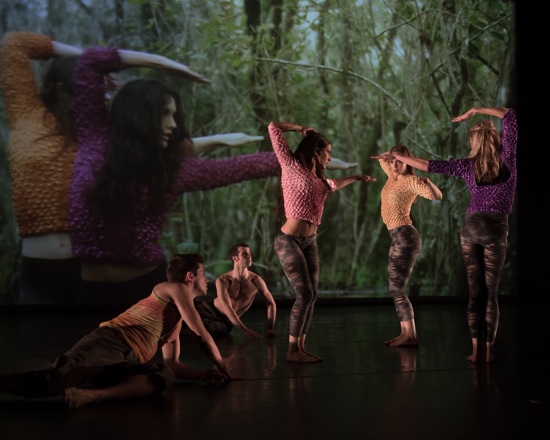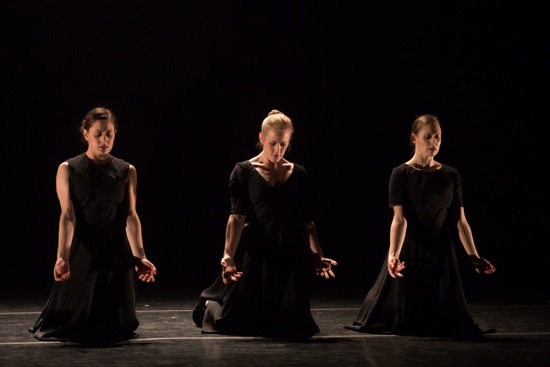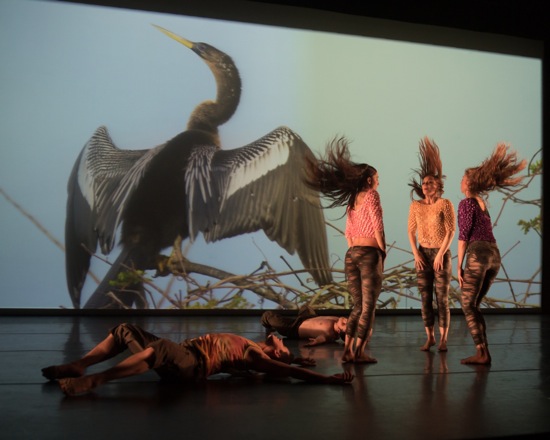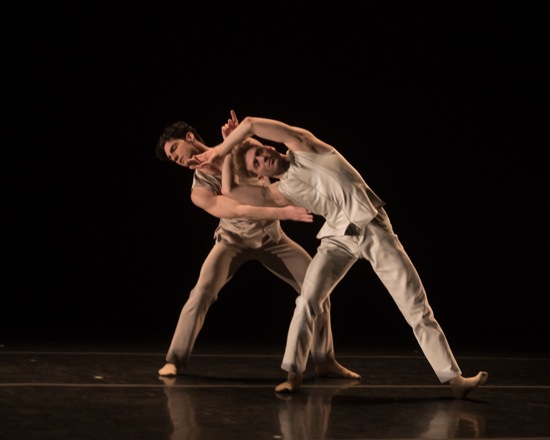
David Parsons’s Dawn to Dusk. (L to R) Eric Bourne, Steven Vaughn, Elena D’Amario, Melissa Ullom, Abby Silva Gavezzoli. Photo: Eric Bandiero
It’s hardly fair to David Parsons to see one of his company’s performances at the Joyce the night after the New York City Ballet’s first all-Tchaikovsky program of the season. Wednesday, Balanchine’s Mozartiana, Thursday, Parsons’s Wolfgang. The company that Parsons founded in 1987 is wildly popular with audiences. He gives them a lot: lively, accomplished dancers; eye-catching lighting (by Howell Binkley) and costumes; variety in terms of subject matter and mood. His movement style, which owes something to his own years as a major dancer in Paul Taylor’s company, is robust, buoyant, and informal in manner (although it can be stark and grotesque when that’s called for). He knows how to structure a piece and pattern its space effectively.
Wolfgang (2005) embodies most of the above. But in terms of musicality, it often rubs up against the Mozart symphonic music it’s set to. For one thing the volume is turned up to rock-concert levels, and the dense-with-steps choreography acknowledges mostly the meter of the music, its climaxes, endings, and new beginnings. Parsons seldom develops phrases in terms of a whole, especially in the fast sections; nor does he always sense the music’s qualities or let it breathe. At one moment, Mozart’s melody rises in pitch, becomes lighter, suspends. And what does Parsons have a dancer do on that topmost sigh? A high kick.
His newest work, Dawn to Dusk, is a color-saturated vision of Florida’s watery landscape. What the company showed at the Joyce is excerpted from a longer work, Face of America: Spirit of South Florida, which was commissioned by Wolf Trap as part of its “Face of America” series. This series sponsors site-specific choreography in the country’s national parks (Barbara Parker of the Wolftrap Foundation for the Performing Arts is listed as Parsons’s choreographic collaborator). The dancers appear on the stage and on screen. They aren’t the only performers. In magnificently clear videos by Blue Land Media and the still photos by Clyde Butcher, snakes twine and flick their tongues, alligators lumber, birds fly across the screen that fills the stage’s backdrop, and a wading bird sticks its long beak into the water. Three pieces of music by Andrew Bird seem appropriate.
Early on, Parsons establishes a connection between the filmed images and the dancers. In footage filmed in the Everglades, an immense alligator slithers along, and onstage, Abby Silva Gavezzoli backs away from it. Then Gavezzoli herself drops to all fours and, briefly, becomes a swamp creature. Later several dancers move along linked together in a sinuous chain like a gator’s tail. We see performers up to their thighs in water: Steven Vaughn, crouches, arms spread, wary as a bird. When wind surges across a landscape of grass and palm trees, the dancers (there are eight in all) roll around the stage.
Some of the dancing catches your eye—Eric Bourne, for instance, moving his hands in sinuous ways. A woman (I forget which) is lifted by the men and swirled in a swan dive position. But the projections overwhelm the live action. The images are so large, so primal that you forget to watch what’s happening in three dimensions right in front of you. And dancers performing synchronized movements while standing in a swamp look out of place.
Dawn to Dusk. How to show that, when the natural light is fading? Here Parsons’s vision takes a strange turn. Suddenly we’re in a Miami hot spot having an evening on the town, and the music is Tiempo Libre’s “Ven Pa Miami.” This is uncomfortably like a scene in a travelogue, but it must be that Parsons sees it as another way to connect animal life with the human species. The gambit doesn’t quite work, even though it’s a pleasure to watch Elena D’Amario party with her pals: Melissa Ullom, Christina Ilisije, Jason MacDonald, Ian Spring, and those already mentioned). Gavezzoli dropping again to all fours just before the lights go out doesn’t quite get the message about our bond with nature across

(L to R): Christine Ilisije, Lauren Garson, Melissa Ullom in Katarzyna Scarpetowska’s Black Flowers. Photo: Eric Bandiero
Katarzyna Scarpetowska, who used to be a member of Parsons Dance and has already choreographed a piece for the company, offered a new work during the Joyce season. Titled Black Flowers, it’s set to two Etudes and two Preludes by Chopin (Scarpetowska is Polish by birth). But Scarpetowska makes you aware of the music primarily in terms of the lyrical, sometimes mournful, sometimes turbulent moods it sets; she doesn’t always breathe with her compatriot.
Her opening is intriguing, three women and two men, wearing black clothes (costumes by Reid Barthelme), stand with their backs to the audience. Slowly, dreamily, they thread their way around one another, never turning their faces to us. The image is almost tidal. In a brief video interview, Scarpetowska said that she thought of the men as part of the women’s memories. That’s not obvious in the choreography, but we do see these people wandering, the women reaching out to touch what isn’t quite there, yet nurturing the men. There is a duet by Bourne and Lauren Garson, after which Garson lashes herself wildly around. MacDonald and Ullom dance together more quietly. At one moment Vaughn jams his head against Ilisije’s belly as if he’s trying to burrow into her.
If the men are remembered lovers, it’s strange to see them without the women: Vaughn in a solo; MacDonald frozen in a lunge, while Bourne stands on the calf of his friend’s leg, as if to see better into the distance.
Parsons Dance offers its audiences a hearty meal of dancing. It’s a lot to try and digest. The program includes his famous solo, Caught, danced at this performance by Bourne, and the vigorously frisky, flashy, sexy finale, In The End.



How well I remember Parsons performing “Caught” in Portland, back in the day when that solo was fresh and new, and so was he as a choreographer. The company was here again about three years ago, “Caught” was performed by a company member, and I remember thinking how stale it had gotten, although the dancer was wonderful I hasten to say. Sounds like there were too many bells and whistles in this show, too bad.
I’ve seen “Caught” recently as well, at Pacific Northwest Ballet, where it was fresh to many people in the audience who don’t really see any modern dance. Interestingly, when I first saw it, not long after its premiere, we were all transfixed by the magical nature of the work. The strobe effect made us feel that the performers existed in an alternate world — that they had actually managed to thwart gravity. Lately, it seems that audiences have a very different response. They gasp, they laugh, they cheer in the middle of the work — it’s like a circus act, perhaps an extension of Cirque du Soleil. They know how the effects are made, and they recognize the physical challenge for the dancers.
I was taken by your comment here:
“In a brief video interview, Scarpetowska said that she thought of the men as part of the women’s memories. That’s not obvious in the choreography,”
With the increasing ubiquity of the internet and the emphasis on process as a part of contemporary art, I think we are being asked to look at a performance as just one component of a much larger art work, from the initial preparation to the post-show analysis. This takes a fairly intense level of involvement on the part of the audience — they commit to doing much more homework than they have in the past. As a critic, I’m used to this requirement, but it’s interesting to feel that the artist wants all of the audience to participate at this level. I’ve always thought that the work itself should reflect what the artist intends — if it doesn’t show up in the performance, it plays a secondary role for the audience. Essentially, it’s the difference between a preview and a review — the preview is the dance in the artist’s head, and the review is the dance I see in the theater, sitting with all those people who might not have done the reading.